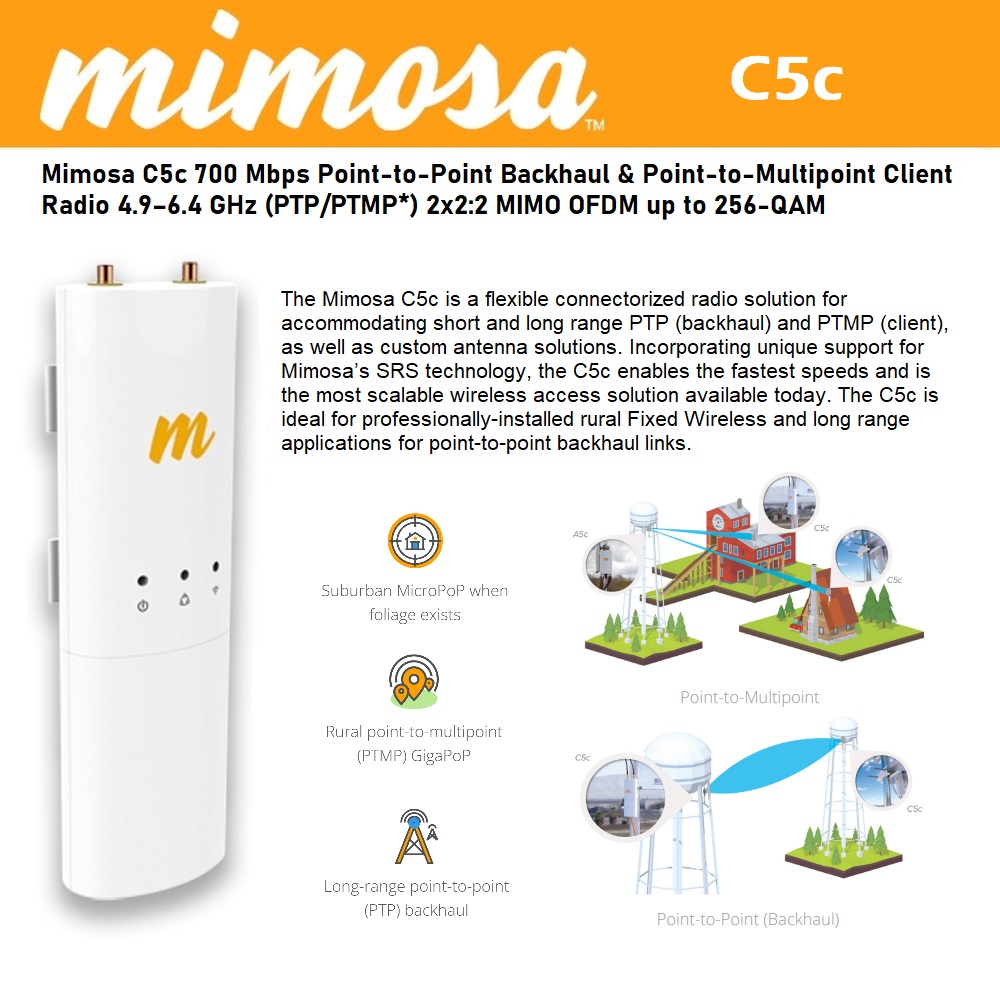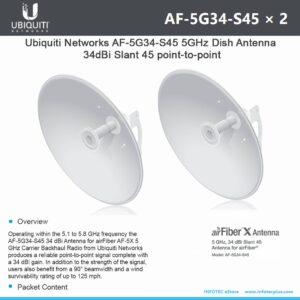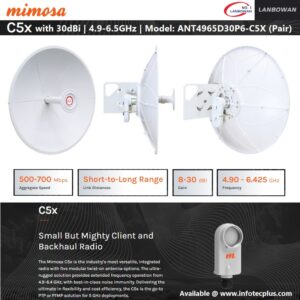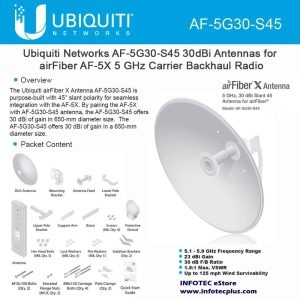Mimosa C5c Radio with 24V PoE
₨41,000.00
Mimosa C5c has been designed specifically to handle long-range backhaul (PTP), point-to-multipoint (PTMP) GigaPoP links, and PTMP MicroPoP links impaired by vegetation. Connectorized by design, the C5c mates with many popular antennas, delivering 700 Mbps of TCP throughput.
Package includes:
– Mimosa C5c Radio Qty: 1 peice
– PoE Adapter Qty: 1 piece
Datasheet
The Mimosa C5c is a flexible connectorized radio solution for accommodating short and long range PTP (backhaul) and PTMP (client), as well as custom antenna solutions. Incorporating unique support for Mimosa’s SRS technology, the C5c enables the fastest speeds and is the most scalable wireless access solution available today. The C5c is ideal for professionally-installed rural Fixed Wireless and long range applications for point-to-point backhaul links.
Flexible Antenna Options
Connect to virtually any dual polarization antenna to custom engineer longer distance client links. The C5c
has dual RP-SMA connectors for easy cabled antenna connectivity. It can be mounted to any pole via hose
clamps or easily clipped onto antennas supporting compatible clip-on mounting bracket systems.
PTP Backhaul Links
The C5c provides extreme price/performance for PTP backhaul links in a small form factor. Wide frequency range support allows avoidance of crowded 5 GHz spectrum bands. Where regulations
allow, long distances are enabled with high system power and flexible antenna options.
SRS Client
The C5c offers client-side support for Mimosa’s proprietary Spectrum Reuse Synchronization (SRS)
technology. This ensures each client device precisely receives and transmits under the timing control
of the access point and can dynamically request upstream bandwidth. As opposed to alternative
(fixed) timeslot protocols, upstream bandwidth and latencies are allocated on demand which enables
significantly higher overall upstream network bandwidth utilization.
| Performance | |
| Max Throughput | PTP/PTMP: 700 Mbps IP (866 Mbps PHY) |
| Wireless Protocols | WiFi Interop Mimosa SRS |
| Modes | PTMP Client PTP Backhaul |
| Radio | |
| MIMO & Modulation | 2×2:2 MIMO OFDM up to 256 QAM |
| Bandwidth* | 20/40/80 MHz channels tunable to 5 MHz increments for Mimosa SRS; Tunable to standard WiFi channels for WiFi Interop |
| Frequency Range | PTMP: 4900-6400 MHz*** PTP: 4900-6400 MHz Restricted by country of operation *new* US/FCC 5600-5650 MHz support FCC DFS (U-NII-2a, U-NII-2c) availability pending certification |
| Max Output Power | 27 dBm |
| Sensitivity ( MCS 0 ) | -87 dBm @ 80 MHz -90 dBm @ 40 MHz -93 dBm @ 20 MHz |
| Power | |
| Max Power Consumption | 9.2 W |
| System Power Method | Passive PoE (24-56 VDC) |
| PoE Power Supply | Passive POE compliant, 48-56 V Power over Ethernet supply (Not Included) |
| Physical | |
| Dimensions | Depth 44 mm (1.73″) Width 65 mm (2.56″) Height 188.4 mm (7.42″) |
| Weight | 295 grams (10.4 oz) |
| Mounting | Single pole strap |
| Connector Type | RP-SMA (x2) |
| Environmental | |
| Outdoor Ingress Protection Rating | IP55 |
| Operating Temperature | -40°C to +55°C (-40°F to 131°F) |
| Operating Humidity | 5 to 100% condensing |
| Operating Altitude | 4420 m (14501′) maximum |
| Shock & Vibration | ETS 300-019-2-4 class 4M5 |
| Features | |
| Gigabit Ethernet | 10/100/1000-BASE-T |
| Management Services | Mimosa cloud monitoring and management, SNMPv2 & Syslog legacy monitoring, HTTPS, HTML 5 based Web UI |
| Smart Spectrum Management | Active scan monitors/logs ongoing RF interference across channels (no service impact) Dynamic auto-optimization of channel and bandwidth use |
| Security | WPA2 + Mimosa 802.1x Client** |
| QoS | Supports 4 pre-configured QoS levels |
| Regulatory + Compliance | |
| Approvals | FCC Part 15.407 and Part 90Y, IC RSS210, CE, ETSI 301 893/302 502 |
| Other National Regulations | |
| RoHS Compliance | Yes |
| Safety | UL/EC/EN/ 60950-1 + CSA-22.2 |
* 4.9 GHz uses 20 MHz channel widths (US only, regulations vary by region)
** Enabled in future software release
*** Extended frequency, above 6.2 GHz, requires use of A5/A5c access point with P/N 100-000xx-01
‡ U.S. Pat. No. US 9,001,689 and patents pending.









